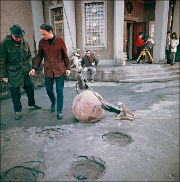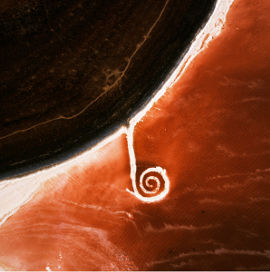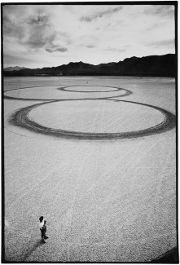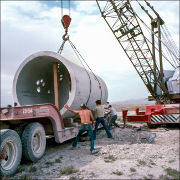
|
WHERE TIME MEETS SPACE – JAMES CRUMP’S "TROUBLEMAKERS:
THE STORY OF LAND ART" "The present must go into the places where
remote futures meet remote pasts." -- Robert Smithson,
The raison d’etre of holy spaces from time immemorial – from caves to cathedrals, from stupas to mosques – is immersion in transcendent mystery. In a post-World War II secular age, Abstract Expressionists made paintings to afford something akin to this kind of experience. Mark Rothko told the painter Ethel K. Schwabacher he dreamt of having small chapels along the roads, where travelers could stop and commune with his paintings, "a kind of exalted rest stop somewhere between the drive-through and the motel" (Randy Kennedy. "In ‘Mark Rothko: From the Inside Out,’ a Son Writes About His Father." New York Times. Dec. 11, 2015). This is precisely what the art patrons John and Dominique de Menil made possible for Rothko in Houston, Texas, with the Rothko Chapel in 1971, the year after the painter’s death.
Into our intellectually constricted era of cynicism and self-absorption comes a timely antidote in "Troublemakers: The Story of Land Art," James Crump’s definitive documentary on the Land Art of Michael Heizer, Robert Smithson, Walter De Maria, Nancy Holt, and Dennis Oppenheim, opening January 8th at the IFC Center in New York City. For our world of narrow narcissism and trivialized themes, of excess that makes the Gilded Age pale, of the rejection of both science and philosophy (inquiry into questions of knowledge, truth, reason, reality, meaning, value), "Troublemakers" serves as a valuable reminder of a particular cohort of artists who were existentially committed to ideas and ideals greater than themselves. Unlike the ragtag, fragmented protest groups of today, e.g., Occupy Wall Street, cohesive movements characterized the zeitgeist of the ‘60s. The student, black power, anti-war, environmental, and civil, women’s and gay rights movements were confident and well-organized by comparison – and young artists, like their peers, felt empowered to confront the establishment. These artists saw themselves as real and powerful instruments of meaningful social change. Civil enfranchisement, anti-war conviction, environmental stewardship – these issues raised moral concerns serious people of the time felt compelled to confront. In addition, this generation of artists came of age in the midst of another cultural phenomenon. NASA’s space program took us through a series of firsts that would change our perception of Earth. With Apollo 8’s 1968 photograph of an externalized orb and again in 1972 with Apollo 17’s iconic Blue Marble image, we saw our habitat as a deified object floating in the vastness of space. Within this seismic shift of perception, intellectuals across the board were disgruntled with the status quo, among them visual artists fed up with the gallery system, and so they sought nothing short of the utter de-commodification of art production. These artists wanted to return art to a prehistoric, ritualized experience by moving out of the studio and the marketplace and back to Earth itself, guided by a philosophy that shaped the formal concerns of the work. To that end, New York-based independent curator Willoughby Sharp and Liza Béar, an underground magazine editor who had moved to New York from London in 1968, founded Avalanche magazine and published 13 issues from 1970 to 1976. Avalanche eschewed critics, instead examining art from artists’ perspectives by relying almost exclusively on the interview format. In addition, Sharp wanted to de-emphasize New York as the center of the art world by focusing on European as well as American artists. Conceptual artists like Walter De Maria, Dennis Oppenheim, and Robert Smithson, who were beginning to venture into earthworks, were among the many artists Sharp promoted through the magazine. No revolution, artistic or otherwise, occurs within a vacuum. If, in the nascent formation of their ideas, these artists envisioned creating on such a scale and in such novel ways as to reject galleries, they also relied on iconoclasts like Sharp and Béar, as well as gallerists, curators, and patrons of every stripe to recognize their vision and embrace the entrepreneurial courage to promote it. At one point in "Troublemakers," sculptor
Charles Ross relates the story of his search for a site for Star Axis,
a naked eye observatory he has been in the process of constructing
for over 40 years outside the village of Anton Chico in northeast
New Mexico.
Around the same time that Dwan mounted the Earth Works gallery show, Willoughby Sharp was inviting artists to exhibit in Ithaca, New York, in what would be the first American museum exhibition dedicated to Land Art. Sharp asked twelve artists, of which nine participated: Jan Dibbets of the Netherlands, Hans Haacke and Günther Uecker of Germany, Richard Long of Great Britain, David Medalla of the Philippines, and Neil Jenny, Robert Morris, Dennis Oppenheim, and Robert Smithson of the United States. Michael Heizer and Walter De Maria briefly exhibited but were not included in the catalogue (published a year later), and Carl Andre declined. Earth Art ran from February 11-March 16, 1969 at Cornell University’s White Museum of Art, along with site-specific installations around the campus. Andre notes in the film that, "It was a very prophetic show. It really was not so much work that had been done, but work that artists dreamed of. So it was a show, in a way, of artists’ dreams." Swiss curator and art historian Harald Szeemann’s 1969 Kunstahlle exhibition in Bern, When Attitudes Become Form, brought Land Art together with Conceptual and American Post-Minimalist Art and Italian Arte Povera. Along with Heizer, who used a wrecking ball to smash holes into the sidewalk outside, Richard Serra splashed lead in the foyer, Jan Dibbets excavated a corner to expose the Kunstahlle’s foundation, Lawrence Weiner removed plaster from a portion of wall, and Daniel Buren was arrested for pasting stripes around Bern. The Swiss were not amused.
We hear Dennis Oppenheim recall his early ephemeral work cutting shapes into ice and snow and creating patterns with combine harvesters in wheat fields: "It was an art that took on the world. It took on real land. …. [W]e were dematerializing the object. We were basically reducing the one thing that we could sell to possibly a photograph only. …. This whole notion of sculpture as place and in gouging a line through the field to this sort of island, this pocket – one could imagine a sort of fantasy of timelessness." Heizer’s Double Negative (1969-1970) consists of two trenches cut into the eastern edge of the Mormon Mesa in the Moapa Valley in Nevada on a 60-acre site Dwan purchased for the project. The trenches line up across a large gap formed by the natural shape of the mesas’ edges. Including the open area across the gap, together the trenches measure 1,500 feet long by 50 feet deep by 30 feet wide. Heizer displaced 240,000 tons of rock in the construction of Double Negative that he then deposited in the natural canyon. The "double negative" of the title refers to the natural and to the man-made negative space – to absence, to what is not there. Smithson’s Spiral Jetty (1970) is located at Rozel Point peninsula on the northeastern shore of Great Salt Lake. Smithson constructed the 1,500-foot long by 15-foot wide counterclockwise spiral out of more than 6,000 tons of black basalt rock and earth from the site. How much, if any, of Spiral Jetty is visible on any given day, at any given time depends on natural water fluctuations. The Dwan Gallery, New York provided the initial funds for Spiral Jetty. After Smithson’s untimely death in 1973, three years after its completion, the Dia Art Foundation of New York funded the annual lease of the land surrounding the site.
Much Land Art survives only as conceptual drawings,
maquettes, and photographs, like Oppenheim’s Time Line –
Boundary between USA/Canada along St. John River; Fort Kent, Maine
(1968), which was an ephemeral one-foot by three-foot by three-mile
cut between the two countries; De Maria’s Mile Long Drawing
(1968), which was composed of two parallel chalk lines that temporarily
extended for two miles across the Mojave Desert in California; and
Heizer’s Circular Surface (late ‘60s-early ‘70s),
which was a series of motorcycle drawings in the Nevada dry lakes.
There is, not surprisingly, a then-and-now nostalgia
that permeates the reminiscences in "Troublemakers," not
so much for lost youth (we’ve all felt that) as for a world
of intellectual and cultural engagement – for a time when ideas
mattered and were debated in a spirit of camaraderie among a coterie
that lusted for meaning. The quality of purpose these artists shared
and their youthful seriousness is unambiguous. The earthworks they
left us – a marriage of human creation and natural grandeur
– tether us to the land and transport us into the awe and reverence
and mystery of a pre-technological, pre-industrial, pre-agricultural
sense of being in the world.
It would be my hope that "Troublemakers" encourages a new audience to engage in the natural environment with equal passion and veneration. In February 2014, Crump was shooting footage of Double Negative. He recalls, "At the top, on the edge of the work, you see nothing but horizon and the huge dome of the sky. You begin to sense this incredible vastness of space and your relative insignificance in this remote desert landscape. The energy of the site is palpable. It struck me as no less spiritual than any sacred mesa set aside for Native American rituals. When…we wrapped up the day’s work, it was like saying goodbye to a living, breathing entity." To momentarily return to Rothko, in "The Romantics Were Prompted" (1947), the Abstract Expressionist painter wrote, "Without monsters and gods, art cannot enact our drama: art’s most profound moments express this frustration. When they were abandoned as untenable superstitions, art sank into melancholy. …I do not believe that there was ever a question of being abstract or representational. It is really a matter of ending this silence and solitude, of breaching and stretching one’s arms again." Toward the close of "Troublemakers," Michael
Heizer takes credit for the Land Art movement: "Sure, I invented
that idea." Speaking today, Carl Andre responds to that notion
with the necessary corrective: “No, no, no. Stonehenge was there
before any of them, and the Indian Serpent Mounds….”
|
| museums | NYTW mail | recordings | coupons | publications | classified |








